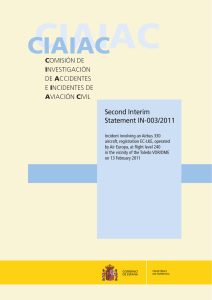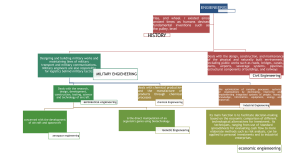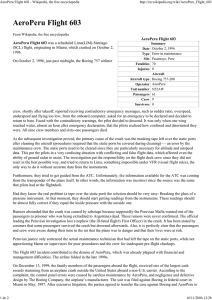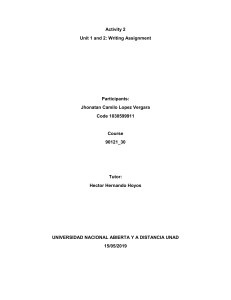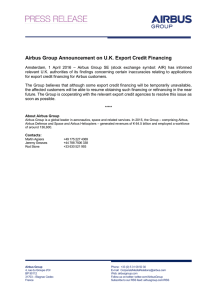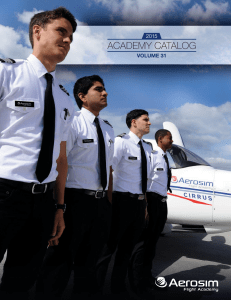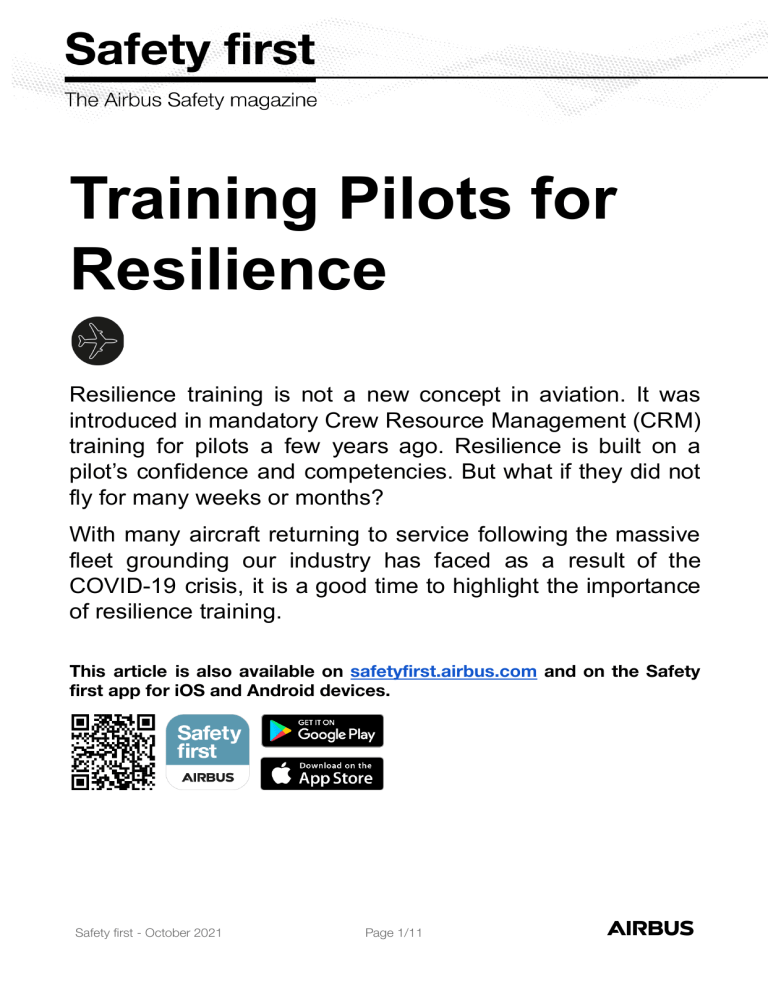
Training Pilots for Resilience Resilience training is not a new concept in aviation. It was introduced in mandatory Crew Resource Management (CRM) training for pilots a few years ago. Resilience is built on a pilot’s confidence and competencies. But what if they did not fly for many weeks or months? With many aircraft returning to service following the massive fleet grounding our industry has faced as a result of the COVID-19 crisis, it is a good time to highlight the importance of resilience training. This article is also available on safetyfirst.airbus.com and on the Safety first app for iOS and Android devices. Safety first - October 2021 Page 1/11 THE NEED FOR RESILIENCE When an A300 cargo aircraft was hit on the left wing by a surface-to-air missile, all three hydraulic systems were lost. The Captain who was Pilot Flying immediately realized that engine control was the only means to safely land the aircraft. This was done by applying symmetric thrust control to adjust the pitch and speed, and asymmetric thrust control to adjust the bank angle. He did this based on the memory of a similar event that occurred a few years before when the flight crew took the initiative to use differential thrust to manage the loss of all hydraulic systems. The landing gear was extended by gravity and the flight crew eventually managed to land the aircraft without causing any injuries. This was a clear demonstration of flight crew resilience in an extraordinary situation. Events like these may be considered as extreme startle events that a majority of flight crews may never see in their flying careers. Some may believe that training for resilience is only useful for such rare situations. Resilience is in fact useful anytime an unexpected situation occurs. An unexpected situation is not necessarily an extreme case such as the A300 example above. Resilience training for flight crews will help them to overcome the startle effect and temporary loss of situational awareness, to react in a controlled manner, and to continue a safe flight. What is resilience? The term resilience has become widely used in recent years, and not only in aviation. Resilience is used to qualify and evaluate human performance when faced with unexpected disruptions in operation. EASA has defined flight crew resilience as, “the ability of a flight crew member to recognize, absorb and adapt to disruptions”. Two key elements: competence and confidence This high-level definition of resilience has been refined into two key elements by the Pilot Training Task Force (PTTF) of IATA: “flight crew resilience can be substantiated by raising the level of competence and by achieving the appropriate level of confidence (trust)” (fig.1). In other words, to build their resilience, the flight crew needs to develop their competencies and their confidence. (fig.1) The two pillars of Resilience: Competence and Confidence Safety first - October 2021 Page 2/11 To build their resilience, the flight crew needs to develop their competencies and their confidence One main cause: the startle effect When a flight crew is exposed to unexpected disruptions, they may experience a physiological reaction, known as the startle effect. This involuntary and uncontrollable reaction may be accompanied by a momentary loss of situational awareness resulting in a temporary deterioration in performance. The goal of resilience training is to minimize this deterioration and to enable the flight crew to recover performance as quickly as possible (fig.2). (fig.2) Chart showing how training to increase the level of flight crew resilience can support faster performance recovery following a “startle” event. One main enemy: routine Resilience is the ability to adapt to changing situations. Routine reduces this ability. Facing the same situations over again when training or during operations can create rigid patterns of actions. When rigid routines are established, it will require more effort from the flight crew to adapt to an unexpected situation. Unexpected but not always abnormal The “disruptions” mentioned in the EASA definition of resilience do not refer only to an abnormal situation associated with a failure or a critical event. A disruption can be any deviation from the expected plan. For example, when the flight crew is suddenly cleared direct to the FAP even though they expected to follow the entire STAR as usual. This disruption in operations requires resilience to some extent and for the flight crew to quickly adapt to the unexpected situation. The importance of resilience A flight crew will demonstrate resilience by the actions they perform to maintain sufficient safety margin following an unexpected or ‘startle’ event. How they apply their competencies to communicate, manage their workload, and make decisions, is illustrative of their level of resilience to these kinds of events and how they manage the threats and errors. Resilience training for pilots throughout the process of pilot selection, education, training, and assessment has become an important element of flight safety. Safety first - October 2021 Page 3/11 When rigid routines are established, it will require more effort from the flight crew to adapt to an unexpected situation. EVOLUTION OF TRAINING TOWARD MORE RESILIENCE Task-Based vs. Competency-Based Training Flight crew training was traditionally a task-based approach, which evolved into a competency-based approach. This places priority on training and assessment of a finite number of competencies over the training of tasks alone. Airbus decided to move from task-based training and checking to a competency-based training and assessment program in 2014 with the introduction of the A350 Type Rating. Task-based training approach Traditional approaches to training development involve separating jobs into tasks. For each task there is an assigned learning objective with associated elements in a training plan and checks to ensure that all of the learning objectives are met. A limitation of this approach is that each task must be taught and assessed. In complex systems, or when jobs evolve rapidly, it may not be possible to teach and assess every task. Some examples of the tasks to be performed in the recurrent training and checking programs today are listed below: ● ● ● ● ● ● ● ● ● ● ● ● Takeoff with an engine failure Engine failure during the final approach segment Go around with one engine failed Landing with one engine failed Rejected takeoff 3D approach 2D approach System malfunctions in all ATA chapters Low visibility takeoff Low visibility approach Low visibility go around Low visibility landing This task-based training approach is by nature only adapted to predictable scenarios. Flight crews have to apply this task-based approach, while developing their ability to also take into account the operational context. Competency-based training approach ICAO defines competency as, “a dimension of human performance that is used to reliably predict successful performance on the job. A competency is manifested and observed through behaviours that mobilize the relevant knowledge, skills and attitudes to carry out activities or tasks under specified conditions.” In other words, the competency of an individual to proficiently perform on the job is demonstrated through observable behaviors. The observation of these behaviors, which relies on relevant Knowledge, the right set of Skills, and the appropriate Attitude or motivation (KSA), can be used to predict future performance. In Competency Based Training and Assessment (CBTA), the training goal is not to train the flight crew to react to every specific situation, but to be prepared for an infinite number of situations by developing a finite number of competencies. The training and assessment of a finite number of competencies is prioritized over the training of tasks. This should enable pilots to successfully perform in a complex and changing operational environment. They should also be able to manage tasks and Safety first - October 2021 Page 4/11 In CBTA, the training goal is to be prepared for an infinite number of situations by developing a finite number of competencies. situations that are unforeseen, and for which they have not been specifically trained. This builds strong resilience. For instance, EASA defines nine competencies (also used by Airbus) for flight crew training: ● ● ● ● ● ● ● ● ● Application of knowledge Application of procedures and compliance with regulations Communication Flight Path Management - Automation Flight Path Management - Manual control Leadership and Teamwork Problem Solving and Decision making Situation awareness and management of information Workload management Observable behaviors are associated with each defined competency and are used for training and assessment purposes through a variety of scenarios. An assessment of competence is of course necessary in CBTA, but when completed, it provides the opportunity for pilots to learn most effectively when they are not under test conditions. Task-Based Approach Competency-Based Approach ➔ Ever growing number of tasks to train ➔ Finite number of competencies to train ➔ Train only for predicted situations ➔ Train for unpredicted situations ➔ Isolated task training: difficulty to adapt ➔ Multi scenario-based training: strengthens ability to adapt ➔ More time spent on checking ➔ More time spent on training ➔ Generic training ➔ Individualized training ➔ Limited level of performance in complex and evolving environments ➔ Increased level of performance in complex and evolving environments LOW RESILIENCE HIGH RESILIENCE CBTA: Old concept, new application The competency-based training approach has existed since the late 1950s. It has been progressively deployed in the aviation industry since the 2000s with the Multi-crew Pilot License (MPL) introduced in 2006, which was the first CBTA program for licensing training. The first CBTA program for recurrent training was introduced in 2013 with Evidence-Based Training (EBT). In 2016, ICAO published Amendment 5 to ICAO Doc 9868 Procedures for Air Navigation Services - Training (PANS-TRG), which introduced general provisions for CBTA. The revision of ICAO Annex 1, published in 2020, recommends the use of CBTA as a principle of training in a wide range of other aviation disciplines such as Air Traffic Control, Aircraft Maintenance, and Flight Dispatch. Safety first - October 2021 Page 5/11 The latest PANS-TRG revision, published in 2020, further develops the CBTA training method as an important tool to ensure safe operations. It requires pilots to “demonstrate resilience when encountering an unexpected event”. In the light of the COVID-19 pandemic and its impact on our industry, IATA published the “Guidance for post-COVID Restart of Operations: CBTA Training Solutions”. The objective of this document is to provide guidance on training solutions to ensure a safe and efficient restart of operations after a long period of inactivity. Additionally, Airbus introduced the Airbus Pilot Relaunch Program (APRP). The aim of the APRP is to enable flight crews of Airbus aircraft to do training to reinforce operational fundamentals after a long period without flying. The content of the training depends on the level of training requested by the Operator and on the flight crew competencies to be reinforced. Example of CBTA: Evidence-Based Training (EBT) IATA launched a qualitative initiative in 2007 to review the recurrent training system for flight crews, supported by ICAO and the International Federation of AirLine Pilots’ Associations (IFALPA). It was called the Training and Qualification Initiative (ITQI) and its goal was to continuously reduce the number of incidents and accidents. Previous to this, training was designed in the 1960s when only the second and third generation of commercial jet aircraft were flying, whereas air transport traffic today is mostly made up of third and fourth generation commercial jet aircraft. More information on the four generations of commercial jet aircraft is available on the Airbus accidents statistics website. This modernization of the fleet, and the increasing role of human factors, meant that reevaluating the training tools and methods was necessary. This initiative relied on various data sources such as flight data analysis, air safety reports, Line Observation Safety Audits (LOSA), which includes flight observations, and more specifically threat and error management observations. It also relied on training criticality surveys, which addressed the effectiveness of training by highlighting the difference between the situations faced in line operations and in training. These sources, along with other data, were collected as evidence to evaluate the relevance of training depending on the generation of commercial jet aircraft the pilot is flying. The result of this analysis is the ICAO Doc 9995 Manual of Evidence-Based Training (EBT) published in 2013. It focuses on a competency-based training approach, giving more emphasis to non-technical skills and Crew Resource Management (CRM) and depending on the generation of aircraft flown. More information on the EBT concept can be found in the “Learning From the Evidence” Safety first article, published in July 2014. IATA published the Manual of EBT together with the EBT Implementation Guide, which already highlighted the importance of developing resilience training. IATA and ICAO were supported in their study with in-service data coming from aircraft manufacturers including Airbus and from Operators. This data formed the EBT Data Report, which allowed for a realistic evaluation of the relevance of the training. Safety first - October 2021 Page 6/11 BEST PRACTICES FOR TRAINING RESILIENCE Helping flight crews to be aware of their own resilience The goal of CBTA is to be able to manage any situation, even situations that trainees have not been specifically trained for. Being aware of how well they perform in unpredictable situations can help the flight crew to develop their confidence and build their resilience. The instructor is there to support the trainees to develop this awareness. For example, the instructor can highlight how applying procedures and using checklists when appropriate is already one way to mitigate threats and errors. This maintains an acceptable level of safety and is an illustration of resilience. Similarly, another example of resilience is anticipating crosswind before descent and then reviewing the corresponding procedures to be better prepared for landing. Recognizing and managing the startle effect The use of full-flight simulators is not always necessary for resilience training. An awareness session about the psychological and physiological effects of ‘startle’ can help pilots better understand the ‘startle effect’. They will be able to better recognize how they respond to unexpected disruptions in their daily routines and how they react to them. Knowing the physiological effects of ‘startle’ and controlling the initial response is an essential part of increasing a pilot’s own resilience and can prevent incorrect actions on the aircraft controls. For more information about startle management, you can watch the video “The Two Sides of Fear” available on Airbus Worldwide Instructor News (WIN) website. Safety first - October 2021 Page 7/11 Exposing flight crews to different situations Engine failure, autopilot disconnection in cruise, turbulence, and wake vortex encounters are some examples of situations that flight crews should be exposed to when training for resilience. Increasing the variety of situations will reduce the risk of a pilot forming behaviors that are too rigid due to the repetition of the same situations and affecting their ability to adapt to new ones. Behaviors that are too rigid or automatically applied are much more difficult to transfer to an unexpected situation. All Airbus Type Rating courses today offer multiple-choice scenarios, both operational and technical that the instructor can select. Multiple-choice scenarios provide the element of surprise to the flight crews and increase the variety of unexpected scenarios they can encounter. This allows for the design of better resilience training and assessment. Adapting training scenarios The training scenarios should be well suited to the existing competencies of the flight crews. The instructor should adapt the training scenario based on the pilot’s previous assessment. It is recommended that the instructor end the training session in a positive manner with a situation that the pilot will be confident to manage with a successful outcome. Importance of the debriefing Highlighting the positive Increasing resilience relies heavily on the principle of reinforcing confidence. Highlighting the positive outcomes during a debriefing session is essential to this. Instructors are still required to record notes of any observations during the training session, to give feedback, and to focus on them in future training sessions. However, to only focus on the errors or inadequacies of the pilot’s performance can have the unintended effect of decreasing their level of resilience. Facilitation technique A simple way to ensure a constructive debriefing session is to allow the trainees to debrief themselves and reflect on what they have done to reach a safe outcome. The instructor may notice that they will not need to add many additional observations. They can, therefore, pay more attention to developing mitigation strategies together with the trainee to avoid any deficiencies in the future. This will help build the trainee’s confidence and increase their level of resilience. CBTA is still relevant If the instructor considers that the facilitated debriefing is not sufficient to correct the root-cause of the problem, they should recommend further training. It is advisable to select a different exercise that requires the trainee to use the same competencies to manage the situation. Safety first - October 2021 Page 8/11 A simple way to ensure a constructive debriefing session is to allow the trainees to debrief themselves Debriefing after each flight is also an opportunity to increase the flight crew’s resilience by letting them reflect on how they react to threats and errors, and how they apply their competencies to keep sufficient margins of safety. The Flight Crew Techniques Manual (FCTM) is being updated to include a new part on how to conduct operational briefings. This new part is already available for A350 aircraft, and it will be available for A320/A330/A340/A380 aircraft at the end of 2021 and for A300-600/A310 aircraft in 2022. Debriefing is a powerful tool for long-term safety management. Safety first - October 2021 Page 9/11 The term “resilience” has become widely used in recent years. It is now used in every field of activity, not only in aviation. Resilience describes a Florence BURRATTO Expert in Human Factors flight crew's ability to recognize, absorb, and adapt to disruptions according to EASA’s definition of resilience. for Flight Operations Contributors: Customer Support Capt. Robert GRAEF Head of Pedagogy and Flight Operations Standards - Customer Support With thanks to Capt. Craig Hildebrandt from Product Safety, Thomas Gobeaut from A300/A310 Flight Operations Support, Eric Denoux from Flight Training, Capt. Christian Norden, and Claire Pellegrin. Resilience relies on two pillars: competence and confidence. It is the combination of a flight crew’s confidence to manage unexpected situations and how they apply their competencies in such situations that reflects their level of resilience. The goal of resilience training is to enable the flight crew to recover performance as quickly as possible after they experience the ‘startle effect’ caused by an unexpected situation. The preferred training methodology to strengthen a pilot’s level of resilience is the CBTA approach. Instead of following the traditional task-based approach, which requires checking a continuously growing list of tasks, CBTA focuses on a limited number of competencies applied to a variety of situations. The objective of CBTA is to train pilots to manage any unforeseen situation during flight, and therefore, to develop their resilience when faced with any unexpected events. EBT is a CBTA program that focuses on recurrent training for pilots. It was developed in 2014 by ICAO to increase the level of flight safety through resilience training for pilots, and it has since been adopted by Airbus for all type ratings. The instructor has a key role to play in supporting pilots to strengthen their level of resilience during training sessions. In addition to developing and assessing each trainee’s competencies, the instructor needs to be mindful to reinforce the pilot’s confidence. This is a key component for increasing resilience. Exposing flight crews to a variety of situations, adapting training scenarios to their current level of performance, debriefing using the facilitation technique, or ending the training session on a positive outcome, are just some of the recommendations instructors should follow to increase the level of resilience in their trainees. Targeting a high level of resilience for pilots, but also for cabin crews, air traffic controllers, maintenance personnel and all actors of the air transport system is crucial to ensure an even higher level of safety especially when facing unpredictable or unexpected situations. Safety first - October 2021 Page 10/11 Safety first, 2021. Safety first is published by Airbus S.A.S. 1, rond point Maurice Bellonte - 31707 Blagnac Cedex/France. Editor: Yannick Malinge, Chief Product Safety Officer. Editorial team: Guillaume Estragnat, Vanessa Sadi, Gwyneth Duggan, Tim Roach. 20192534. Reference: X00D16031905. Photos by Airbus. © Airbus S.A.S. 2021 – All rights reserved. Proprietary documents. By taking delivery of this Brochure (hereafter “Brochure”), you accept on behalf of your company to comply with the following guidelines: ● No other intellectual property rights are granted by the delivery of this Brochure than the right to read it, for the sole purpose of information. ● This Brochure and its content shall not be modified and its illustrations and photos shall not be reproduced without prior written consent of Airbus. ● This Brochure and the materials it contains shall not, in whole or in part, be sold, rented, or licensed to any third party subject to payment. This Brochure contains sensitive information that is correct at the time of going to press. This information involves a number of factors that could change over time, affecting the true public representation. Airbus assumes no obligation to update any information contained in this document or with respect to the information described herein. The Airbus magazine contributing to the enhancement of the safety of aircraft operations by increasing knowledge and communication on safety related topics. Safety first is published by the Product Safety department. It is a source of specialist safety information for the use of airlines who fly and maintain Airbus aircraft. It is also distributed to other selected organizations and is available on digital devices. Material for publication is obtained from multiple sources and includes selected information from the Airbus Flight Safety Confidential Reporting System, incident and accident investigation reports, system tests and fight tests. Material is also obtained from sources within the airline industry, studies and reports from government agencies and other aviation sources. All articles in Safety first are presented for information only and are not intended to replace ICAO guidelines, standards or recommended practices, operator-mandated requirements or technical orders. The contents do not supersede any requirements mandated by the State of Registry of the Operator’s aircraft or supersede or amend any Airbus type-specific AFM, AMM, FCOM, MMEL documentation or any other approved documentation. Articles may be reprinted without permission, except where copyright source is indicated, but with acknowledgement to Airbus. Where Airbus is not the author, the contents of the article do not necessarily reflect the views of Airbus, nor do they indicate Company policy. Contributions, comments and feedback are welcome. Enquiries related to this publication should be addressed to: Airbus - Product Safety department (W) 1, rond point Maurice Bellonte 31707 Blagnac Cedex - France safetycommunication@airbus.com Visit us at safetyfirst.airbus.com or install the Safety first app: Airbus S.A.S. shall assume no liability for any damage in connection with the use of this Brochure and of the materials it contains, even if Airbus S.A.S. has been advised of the likelihood of such damage. Safety first - October 2021 Page 11/11
